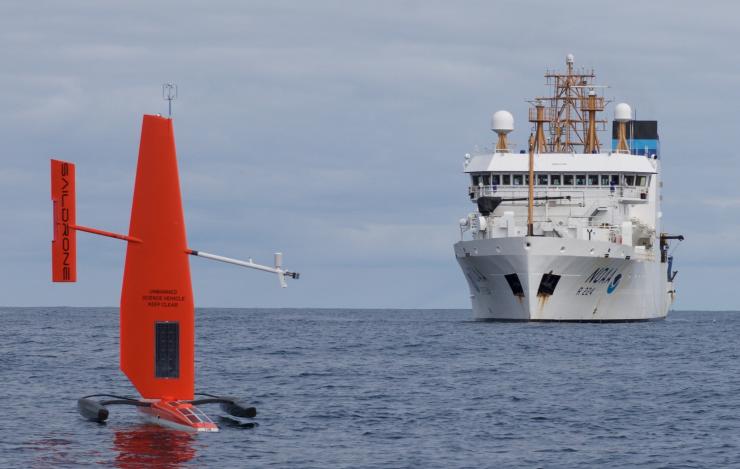Unmanned ‘saildrones’ are headed to the Arctic for science
Researchers hope to sail the vessels as far north as the 75th parallel and plan to study Arctic cod and ocean acidification in the Arctic.

To better understand chemical and ecological changes in the Bering Sea, Chukchi Sea, Beaufort Sea and Arctic Ocean, scientists have launched a small fleet of marine drones.
Four “saildrones” — unmanned, remotely operated, wind- and solar-powered devices that resemble surfboards or sailboards — were launched Saturday by National Oceanic and Atmospheric Administration scientists from the Aleutian port of Dutch Harbor. The devices, made by a California company, will travel north to take measurements and report back data.
For the Alaska work, the saildrones are equipped with sensors to monitor ocean acidification, which is occurring at an accelerated pace in northern Alaska waters, and to get more information on schools of Arctic cod, a high-oil fish that forms much of the diet of Arctic Alaska marine mammals and birds.
The ocean acidification project is led by Jessica Cross, an oceanographer with NOAA’s Pacific Marine Environmental Laboratory in Seattle. For that project, two saildrones will measure carbon dioxide levels in the water.
The saildrones are cost-effective, fast — traveling up to 10 knots — and durable, said Cross. Last year, she and her team got the devices into the Chukchi Sea as far north as Latitude 72, “which was really cool for us and really close to the ice edge,” she said. This year, the team is hoping to go even farther north, perhaps to Latitude 75, she said.
Saildrone USV in action from Sebastien de Halleux on Vimeo.
The Arctic cod project is being led by Alex De Robertis, a fisheries biologist with NOAA’s Alaska Marine Science Laboratory, also in Seattle.
For that project, two saildrones will be equipped with echosounders that will send sound pulses through the water. The sound waves that rebound will give information allowing scientists to map schools of fish and their locations, De Robertis said in an email. It is difficult to distinguish the difference in fish size and species with the echosounder, he said, “so this works best in areas like the Arctic, where a single species and size of fish dominates fish populations in the water.”
There is “surprisingly little” known about Arctic cod and their ecosystems, De Robertis said. There are also potential threats from climate change, he said.
“We know that the environment these fish are living in is undergoing rapid change. Temperatures have increased substantially, and the amount and duration of sea ice has decreased. We don’t know how this will affect the Arctic cod, which are a dominant species that serves as an important food source for whales, birds, seals and fish,” he said in the email.
Among the mysteries is what happens between the time when Arctic cod are juveniles and abundant and the time they are adults and far less abundant, according to NOAA.
Arctic cod is, for now, the most abundant marine fish in the Beaufort and Chukchi seas, according to recent surveys by federal scientists.
This will be the fourth year that NOAA has used saildrones to collect information from far-north Alaska waters. NOAA entered its partnership with Saildrone Inc. in 2014, and the first Bering Sea voyage was in 2015.
There are several advantages to using the unmanned devices instead of manned vessels, said De Robertis and Maggie Mooney-Seus, a NOAA spokeswoman in Seattle.
Although saildrones cannot use nets to capture fish or lower devices deep into the water, as people aboard vessels can do, they can go to hard-to-reach places and they can endure rough weather and other conditions that would be difficult and expensive for manned vessels, the two said.
A big advantage that the saildrones have is their ability to operate until the fall, Cross said. Since they are propelled by wind and their instruments are powered by solar energy, they can operate until daylight dwindles, she said. Expectations are that the saildrones will be working until September of October, she said.
A disadvantage is that the saildrones cannot sample water at depth, and that is where mos acidification is happening, Cross said. So data collected by saildrone will supplement data collected by vessel, she said. She will be doing some of that work this summer when she travels with other researchers on the Coast Guard icebreaker Healy.
Along with past work on ocean acidification monitoring, the saildrones in the past have gathered data and about marine mammals, Mooney-Seus said. In one project last year, video of tagged fur seals was captured by saildrone.
But all has not been smooth sailing with the unmanned devices.
In the first year the saildrones were used, scientists attached sound recorders to try to capture calls of critically endangered North Pacific whales. But the results were mixed, Mooney-Seus said. “You had some sounds of the water hitting the hull, and you had to distinguish that from the whales,” she said. In the following year, some changes were made to get more useful recordings.
The Alaska work is part of a wide NOAA program that will use 11 of the devices this year in projects from the tropical Pacific to the Arctic.
Yereth Rosen is a 2018 Alicia Patterson Foundation fellow.